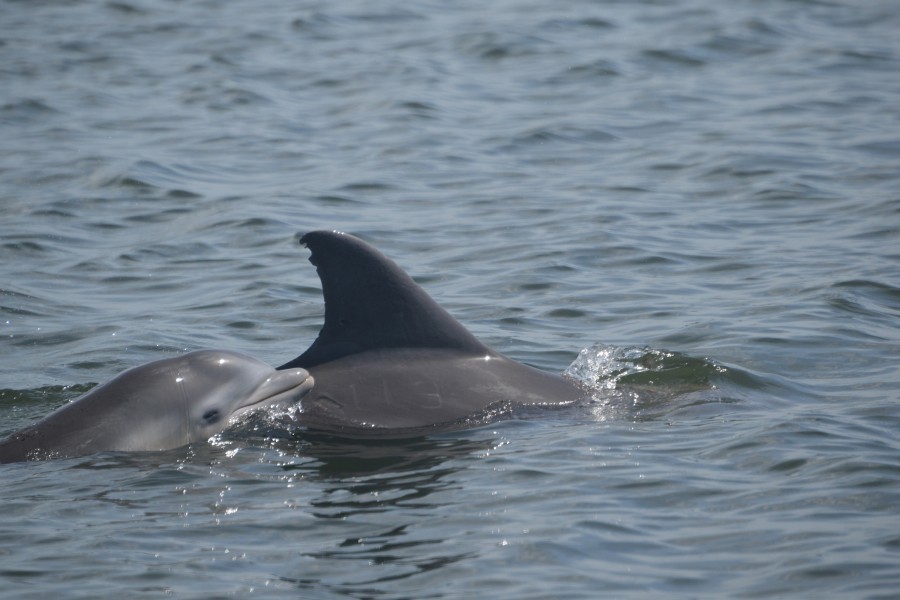- Home
- News
- End-of-year updates from Sarasota Dolphin Research Program

Photo credit: Sarasota Dolphin Research Program. Taken under NMFS permit No. 15443.
- The Sarasota Dolphin Research Program (SDRP, a Chicago Zoological Society Program in collaboration with Mote), continued their monthly dolphin photographic identification population monitoring surveys and fish surveys. So far they have documented 11 new calves accompanying Sarasota Bay resident bottlenose dolphin females in 2018, and seven are still alive. A severe bloom of Florida red tide (Karenia brevis) reached Sarasota Bay in August, and continues, leading to dramatic declines in fish abundance in SDRP surveys. Catches of primary dolphin prey fish in September-November are down more than 90 percent from those in June/July, before the red tide. SDRP staff have expanded their field efforts spatially and temporally to try to document possible changes resulting from the red tide. The Sarasota resident dolphins have redistributed within their community range in response to the red tide, including being seen a bit further offshore and further up rivers and creeks than usual. To date, two long-term resident dolphins have been documented to have died from brevetoxins produced by the red tide, and two resident yearlings died at the end of November, with brevetoxin tests pending. SDRP continues fish sampling and has initiated a biopsy dart sampling program to try to define changes in dolphins’ diet from stable isotope analyses. They are installing remote underwater listening stations around the bay to document the occurrence of dolphin, fish, and vessel sounds, as indicators of the status of the bay, and as a means to monitor eventual recovery of the ecosystem.
- During June 11-15, the Sarasota Dolphin Research Program completed a dolphin health assessment project involving the long-term resident dolphins of Sarasota Bay. Such health “check-ups” are a key part of the data collection conducted through SDRP — the world’s longest-running study of a wild dolphin population. This year, a new component of the 5 days of health assessments involved testing and refining cardiac assessment techniques and developing baseline information for application in subsequent comparative dolphin health assessments in Louisiana and Alabama — where dolphin populations were affected by the Deepwater Horizon oil spill. The work was funded in large part by the Gulf of Mexico Research Initiative through the Consortium for Advanced Research on Marine Mammal Health Assessments (CARMMHA) project, led by the National Marine Mammal Foundation. Over the course of the week, SDRP had 123 participants, with about 95 people on the water each day, including 30 veterinarians and techs, along with biologists, and dolphin handlers from around the world. The team represented more than 20 institutions from the U.S. and other countries working for universities, research institutions, aquariums and federal agencies. Ultimately, the team collected samples from 10 female and 10 male dolphins, ranging from 2 to 48 years old, including six sampled for the first time. More than 40 research projects benefited from each animal sampled. Staff participated in subsequent CARMMHA health assessments in Barataria Bay, Louisiana in July, and off Alabama in September.
- SDRP conducted two photographic identification surveys of dolphins in the waters near Naples and Marco Island, Florida, in collaboration with Rookery Bay National Estuarine Research Reserve, to establish an ongoing dolphin research program in an area of great interest, and to define management units and obtain abundance estimates for the National Oceanic and Atmospheric Administration’s stock assessment reports. Skipper, a young female SDRP disentangled in 2014, was documented during both the May and October sessions. Another session is planned for early 2019.
- SDRP staff received notice of publication of 23 scientific manuscripts, with five more accepted and eight more in review or revision. They also made 18 presentations at professional meetings, and 14 invited public, school, or university lectures.
